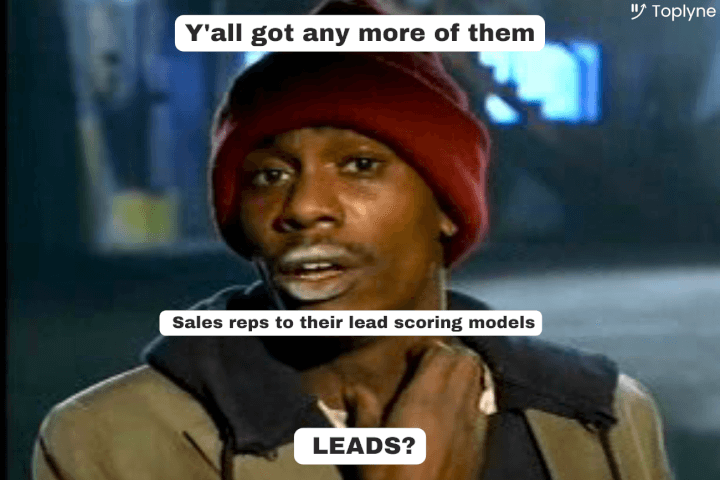What Is Lead Scoring? How it Works (+Tool to Make it Easier)
What Is Lead Scoring? How it Works (+Tool to Make it Easier)
What Is Lead Scoring? How it Works (+Tool to Make it Easier)
Discover everything you need to know about lead scoring, including its benefits, how to calculate it, and a tool that can help you spot the hottest leads.
Discover everything you need to know about lead scoring, including its benefits, how to calculate it, and a tool that can help you spot the hottest leads.
Discover everything you need to know about lead scoring, including its benefits, how to calculate it, and a tool that can help you spot the hottest leads.



Being part of a sales team isn’t easy.
Despite all the best practices, you probably spend days trying to contact and convert potential leads 💰
But what if we told you there’s an easier way to secure the bag?
Say hello to lead scoring!
With lead scoring, you’ll contact high-intent leads or those looking to make a purchase.

How?
Don’t worry! We’ll fill in the gaps.
So, let’s jump in and find out what lead scoring means, its benefits, and how to calculate it.
We’ll also introduce you to a fantastic tool that can automate your lead routing and scoring process and go beyond regular lead scoring software.
What is Lead Scoring?
Lead scoring is used by the sales and marketing departments to determine lead quality.
How does this work?
The lead quality is determined by assigning a point value to each behavior and then adding up all these points for each lead. The lead with the highest score is more likely to convert to a paying customer.
Let’s look at an example.
AKA, time for some math.

Let’s say Lead A:
Downloads the free trial (20 points)
Visits the blog regularly (10 points)
Invited a friend/team member to try out your product (30 points)
This gives Lead A a total of 60 points. 👍
Sounds good, right?
But Lead B:
Downloads the free trial (20 points)
Reads the blog every single day (15 points)
Comments on your social media posts (20 points)
Engages with your email marketing efforts (20 points)
Visits the pricing page often, suggesting they’re interested in more than the free trial (20 points) 💲
This gives Lead B a total of 95 points! 🙌
And, of course, 95 is way better than 60.

As a result:
You’re more likely to convert Lead B into a paying customer than Lead A.
According to the lead scoring criteria, you could also say that Lead B is a “hot lead” while Lead A is a “warm lead.” 🔥
Similarly, if there’s Lead C that only has 10 points for reading your blog, this would make them a “cold lead.” ❄️
Hot (market-qualified) leads are passed on to the sales rep, while warm leads are slowly nurtured and moved down the sales funnel.
(Pro tip: Skip the math with Toplyne. Target users and accounts most likely to convert — automatically!)
Now, let’s look at the factors that can affect lead scores.
Three Types of Information That Affect a Lead Score
There are three main types of information or lead scoring criteria that you need to know about:
1. Explicit Scoring
This lead scoring rule includes critical lead qualification information given by the prospect, such as:
Job title
Email ID
Company name and industry
Location 🌎
Since the prospect gives you the information, it should be accurate (for the most part, but we’ll get to that in negative scoring).
2. Implicit Scoring
Under implicit scoring, you attribute a data point for each of the lead’s previous behaviors, like:
Signing up for a free trial
Requesting a product demo
Using a certain number of product features
Contact form submissions
Email open rate 📧
Since this lead scoring process is purely based on your prospect’s actions, you can easily pick out a hot lead from those higher up in the sales funnel🥳
3. Negative Scoring
Only some leads are worth your time and energy.
After all, a “qualified lead” could be your competitor in disguise!
(Siri, play Sabotage by the Beastie Boys 🎸)
Negative scoring helps you identify such leads and remove them from the equation.
How does it work?
Simple!
Just as you would give a positive value to explicit and implicit information, you can assign a negative point value (e.g., -10 points) to specific characteristics or behaviors, like:
Working in the wrong industry
Long inactivity periods
Unsubscribing from your newsletter 📃or email marketing campaign
A personal email ID (if you’re only selling to businesses)

This way, you receive the complete picture of a lead’s behavior with no surprises!
Three Benefits of Lead Scoring You Must Keep in Mind
Of course, the next logical question is, what is the point of all of this?
Why do you need to do so much math?
We’ll tell you why this is critical for lead qualification or lead management!
1. Increased Sales Effectiveness
Lead scoring can sync up your sales team, so they’re the next PB&J (Pam Beesly and Jim!)

A lead scoring model tells your sales rep which behaviors matter the most. This way, they can tweak their lead generation strategies only to give your sales department hot leads.
As a result, your sales team can focus on essential leads!
At the same time, the marketing department can nurture warm leads to make them piping hot!
The outcome?
An overall smoother sales process for your company! 🚀
2. Ensure Conversions Happen at the Right Time
Converting a lead depends on your sales team following the best practices and making timely decisions. Too early, and you might seem overeager or, worse, desperate 😬
Too late, and they might leave you for your competition😱
A lead scoring model eliminates the guesswork, so your sales team knows exactly when to approach a lead for conversion⏰
Want to avoid watching the clock to know when to approach your lead? Trust Toplyne to hit the right buttons at the right time, ensuring smooth conversions!
3. Higher Win Rate and Expansion Revenue
Lead scoring models allow your sales and marketing team to focus on a qualified lead, increasing the probability of those leads becoming paying customers.
What does that mean?
High conversion rates.
And once you learn how to categorize your lead routing based on intent, you can use the same tools to craft a retargeting strategy too!
So that’s high conversion rates + up-sells and cross-sells = Expansion revenue 💲💲💲
Make way for best salesperson of the year awards!

But here’s the real icing on the cake:
Your salespeople won’t have to work as hard as Dwight for the award. Just use Toplyne to identify and approach every cross sell and upsell opportunity!
Before you reap the benefits of a lead scoring system, you must know how to calculate a lead score in the first place.
B2B Lead Scoring
In the B2B context, lead scoring becomes even more critical as sales cycles are typically longer and involve multiple stakeholders. B2B lead scoring leverages both explicit data, such as company size, industry, and job title, and implicit data, such as engagement with marketing content and website visits, to rank leads accurately.
By focusing on these factors, B2B marketers can identify high-value accounts and prioritize leads that are more likely to convert, ensuring that sales teams invest their time in the most promising opportunities.
Advanced lead scoring models can also incorporate account-level insights and behavioral data to provide a comprehensive view of a prospect's readiness to buy, facilitating a more targeted and efficient sales approach.
How to Calculate a Lead Score
You can calculate a lead score in two ways: manual lead scoring and predictive scoring.
1. Manual or Traditional Lead Scoring
There are four steps to calculating a lead score with traditional or manual lead scoring models:
A) Create Buyer Personas
Before scoring any incoming leads, you need to identify your ideal customer.
Is it someone who will make repeat purchases?
Is it someone who will sign up for most of your new features and offerings?
Perhaps both?
To understand this, you need to know which way your audience is leaning. This is where a buyer persona comes into play.
What is a buyer persona?
A buyer persona is a detailed description of your target audience.
You can create this persona by looking at existing customer data, purchase history, and other engagement metrics.
Creating a buyer persona can help you customize your offerings to different customers to give them EXACTLY what they need.
No more gift baskets to get them to stay!
B) Understand Your Prospects
You need essential information about your prospects along with your buyer personas.
Are they all employees or business owners?
Which industry do they work in?
For instance, a B2B lead scoring model is drastically different from a B2C lead scoring model as the customers’ motivations and expectations are poles apart.
You can find out this information by:
Talking to your sales team: Your sales team interacts with prospects daily. Get their insights on what customers are looking for and what key issues need solving.
Talking to your customers: While your sales team can know a lot, they can’t read your customers’ minds. But you know who can? Your customers! Ask them what they’re looking for and notice the buying trends emerge.
Turning to your analytics: Analyze past sales and marketing campaigns and see what worked and didn’t. Adjust accordingly and see the money flow in! 📊
Pro Tip: You can make this easier by relying on Toplyne’s lead scoring functionality.
C) Choose the Right Data Points to Score
Once you know everything about your prospects, you can decide which data points mean the most to your sales process.
You can look at which past data points have the highest close rates.
For instance, if signing up for a free trial generally leads to a conversion, then go ahead and add that to the list of data points to score! 💃
D) Assign a Point Value to Each action
It would be best if you gave each action a point value to get an accurate representation of how likely that customer is to buy.
Use the data from Step C to determine which actions play a more significant role in purchase decisions and assign higher point values to those actions.
If you have fewer customers or variables, you can probably get away with using a scale of 1–10.
But if you have many customers or data points, we suggest going for a 1–100 scale. This gives you the most accurate and actionable information. 💯
E) Evaluate Leads Based on Their Behavior
Once you have your data points and scores for each behavior, calculate!
You can do this on paper or in your CRM (Customer Relationship Management) system.
But is this all starting to feel cumbersome?

You’re not wrong!
Defining a manual lead scoring rule can take time and effort. On top of that, it doesn’t always consider each critical data point — like how many times a specific prospect visits your pricing page.
This can mean leads are slipping through the cracks, and you lose sales!

But we have a solution.
2. Predictive Lead Scoring
With predictive lead scoring, you can automate the entire lead scoring process 🤩
How?
It’s simple — you use a lead scoring tool, so you don’t have to do any calculations.

But that’s not all!
A lead scoring tool with the predictive scoring model can calculate complex and dynamic information, which isn’t possible to do manually.
For example, a predictive lead scoring system can determine which leads are more likely to convert based on how many times they visited your pricing page.
The bottom line: With the right lead scoring software, you can also consider massive amounts of data and touchpoints in a flash⚡
No more waiting around with hundreds of leads piling up!
The predictive software uses machine learning algorithms to search current and past customer data. This means you gain insight into which behaviors are most likely to signal that a lead is ready for conversion.
Looking for a lead scoring tool?
We’ve got something even better.
Go Beyond Lead Scoring with Toplyne!
Lead scoring is the beginning of lead management. Your sales team will still have to do the hard work of going after those high-potential leads.
But….
What if a one-of-a-kind tool intelligently scores every lead and suggests in-app actions and sales-assist motions to match the user’s intention?
Not a tall ask for Toplyne😏
This special headless sales AI can single-handedly:
Build you a pipeline of product-qualified leads
Spike up your win rate
Boost your Net Revenue Retention (NRR)!
That’s right!
You don’t need to invest in a separate lead scoring system. Toplyne does this and much more!
The best part?
Toplyne is headless! It’s a snug fit for your existing sales suite. So don’t worry about overhauling processes or change management at all!
Here’s how companies like Canva and Vercel generate sales pipeline from their self-serve funnel using Toplyne:
Step 1/7: Create monetization playbooks to surface conversion and expansion opportunities (leads most likely to convert to paying customers, and teams most likely to grow into larger teams)

Step 2/7: Choose the right leads to target – users (individual users) or accounts (a group of users with an organization).

Step 3/7: Select the frequency at which you would want leads synced in your GTM apps.

Step 4/7: Define how many leads you want by either the number of leads or your expected win rate, depending on your sales capacity and GTM strategy.

Step 5/7: Build custom segments - Build custom segments based on And/Or logic at the deepest level of sub-properties within your product analytics.

Step 6/7: Validate your GTM strategy - Hold back some users as a control group to test your GTM strategy.

Step 7/7: Sync your product qualified pipeline into your GTM destinations - CRMs, sales & marketing execution tools, and customer engagement platforms.

It’s that simple!
Let the computer take over while you sit back and enjoy a champagne shower!

Score Big with Toplyne!
Lead scoring is an essential part of the sales process. But it doesn’t have to suck your soul out! Fortunately, you can keep things simple with predictive lead scoring.
But lead scoring alone is only part of the sales puzzle. Ultimately, it would be best if you had a unique tool like Toplyne to assist your sales team through the intricate parts of the sales process by building an effective PQL pipeline.
You won’t have to wait too long for a definite uptick in your win rates and NRR!
What are you waiting for?
Sign up for Toplyne’s free trial right now, and get going!

Being part of a sales team isn’t easy.
Despite all the best practices, you probably spend days trying to contact and convert potential leads 💰
But what if we told you there’s an easier way to secure the bag?
Say hello to lead scoring!
With lead scoring, you’ll contact high-intent leads or those looking to make a purchase.

How?
Don’t worry! We’ll fill in the gaps.
So, let’s jump in and find out what lead scoring means, its benefits, and how to calculate it.
We’ll also introduce you to a fantastic tool that can automate your lead routing and scoring process and go beyond regular lead scoring software.
What is Lead Scoring?
Lead scoring is used by the sales and marketing departments to determine lead quality.
How does this work?
The lead quality is determined by assigning a point value to each behavior and then adding up all these points for each lead. The lead with the highest score is more likely to convert to a paying customer.
Let’s look at an example.
AKA, time for some math.

Let’s say Lead A:
Downloads the free trial (20 points)
Visits the blog regularly (10 points)
Invited a friend/team member to try out your product (30 points)
This gives Lead A a total of 60 points. 👍
Sounds good, right?
But Lead B:
Downloads the free trial (20 points)
Reads the blog every single day (15 points)
Comments on your social media posts (20 points)
Engages with your email marketing efforts (20 points)
Visits the pricing page often, suggesting they’re interested in more than the free trial (20 points) 💲
This gives Lead B a total of 95 points! 🙌
And, of course, 95 is way better than 60.

As a result:
You’re more likely to convert Lead B into a paying customer than Lead A.
According to the lead scoring criteria, you could also say that Lead B is a “hot lead” while Lead A is a “warm lead.” 🔥
Similarly, if there’s Lead C that only has 10 points for reading your blog, this would make them a “cold lead.” ❄️
Hot (market-qualified) leads are passed on to the sales rep, while warm leads are slowly nurtured and moved down the sales funnel.
(Pro tip: Skip the math with Toplyne. Target users and accounts most likely to convert — automatically!)
Now, let’s look at the factors that can affect lead scores.
Three Types of Information That Affect a Lead Score
There are three main types of information or lead scoring criteria that you need to know about:
1. Explicit Scoring
This lead scoring rule includes critical lead qualification information given by the prospect, such as:
Job title
Email ID
Company name and industry
Location 🌎
Since the prospect gives you the information, it should be accurate (for the most part, but we’ll get to that in negative scoring).
2. Implicit Scoring
Under implicit scoring, you attribute a data point for each of the lead’s previous behaviors, like:
Signing up for a free trial
Requesting a product demo
Using a certain number of product features
Contact form submissions
Email open rate 📧
Since this lead scoring process is purely based on your prospect’s actions, you can easily pick out a hot lead from those higher up in the sales funnel🥳
3. Negative Scoring
Only some leads are worth your time and energy.
After all, a “qualified lead” could be your competitor in disguise!
(Siri, play Sabotage by the Beastie Boys 🎸)
Negative scoring helps you identify such leads and remove them from the equation.
How does it work?
Simple!
Just as you would give a positive value to explicit and implicit information, you can assign a negative point value (e.g., -10 points) to specific characteristics or behaviors, like:
Working in the wrong industry
Long inactivity periods
Unsubscribing from your newsletter 📃or email marketing campaign
A personal email ID (if you’re only selling to businesses)

This way, you receive the complete picture of a lead’s behavior with no surprises!
Three Benefits of Lead Scoring You Must Keep in Mind
Of course, the next logical question is, what is the point of all of this?
Why do you need to do so much math?
We’ll tell you why this is critical for lead qualification or lead management!
1. Increased Sales Effectiveness
Lead scoring can sync up your sales team, so they’re the next PB&J (Pam Beesly and Jim!)

A lead scoring model tells your sales rep which behaviors matter the most. This way, they can tweak their lead generation strategies only to give your sales department hot leads.
As a result, your sales team can focus on essential leads!
At the same time, the marketing department can nurture warm leads to make them piping hot!
The outcome?
An overall smoother sales process for your company! 🚀
2. Ensure Conversions Happen at the Right Time
Converting a lead depends on your sales team following the best practices and making timely decisions. Too early, and you might seem overeager or, worse, desperate 😬
Too late, and they might leave you for your competition😱
A lead scoring model eliminates the guesswork, so your sales team knows exactly when to approach a lead for conversion⏰
Want to avoid watching the clock to know when to approach your lead? Trust Toplyne to hit the right buttons at the right time, ensuring smooth conversions!
3. Higher Win Rate and Expansion Revenue
Lead scoring models allow your sales and marketing team to focus on a qualified lead, increasing the probability of those leads becoming paying customers.
What does that mean?
High conversion rates.
And once you learn how to categorize your lead routing based on intent, you can use the same tools to craft a retargeting strategy too!
So that’s high conversion rates + up-sells and cross-sells = Expansion revenue 💲💲💲
Make way for best salesperson of the year awards!

But here’s the real icing on the cake:
Your salespeople won’t have to work as hard as Dwight for the award. Just use Toplyne to identify and approach every cross sell and upsell opportunity!
Before you reap the benefits of a lead scoring system, you must know how to calculate a lead score in the first place.
B2B Lead Scoring
In the B2B context, lead scoring becomes even more critical as sales cycles are typically longer and involve multiple stakeholders. B2B lead scoring leverages both explicit data, such as company size, industry, and job title, and implicit data, such as engagement with marketing content and website visits, to rank leads accurately.
By focusing on these factors, B2B marketers can identify high-value accounts and prioritize leads that are more likely to convert, ensuring that sales teams invest their time in the most promising opportunities.
Advanced lead scoring models can also incorporate account-level insights and behavioral data to provide a comprehensive view of a prospect's readiness to buy, facilitating a more targeted and efficient sales approach.
How to Calculate a Lead Score
You can calculate a lead score in two ways: manual lead scoring and predictive scoring.
1. Manual or Traditional Lead Scoring
There are four steps to calculating a lead score with traditional or manual lead scoring models:
A) Create Buyer Personas
Before scoring any incoming leads, you need to identify your ideal customer.
Is it someone who will make repeat purchases?
Is it someone who will sign up for most of your new features and offerings?
Perhaps both?
To understand this, you need to know which way your audience is leaning. This is where a buyer persona comes into play.
What is a buyer persona?
A buyer persona is a detailed description of your target audience.
You can create this persona by looking at existing customer data, purchase history, and other engagement metrics.
Creating a buyer persona can help you customize your offerings to different customers to give them EXACTLY what they need.
No more gift baskets to get them to stay!
B) Understand Your Prospects
You need essential information about your prospects along with your buyer personas.
Are they all employees or business owners?
Which industry do they work in?
For instance, a B2B lead scoring model is drastically different from a B2C lead scoring model as the customers’ motivations and expectations are poles apart.
You can find out this information by:
Talking to your sales team: Your sales team interacts with prospects daily. Get their insights on what customers are looking for and what key issues need solving.
Talking to your customers: While your sales team can know a lot, they can’t read your customers’ minds. But you know who can? Your customers! Ask them what they’re looking for and notice the buying trends emerge.
Turning to your analytics: Analyze past sales and marketing campaigns and see what worked and didn’t. Adjust accordingly and see the money flow in! 📊
Pro Tip: You can make this easier by relying on Toplyne’s lead scoring functionality.
C) Choose the Right Data Points to Score
Once you know everything about your prospects, you can decide which data points mean the most to your sales process.
You can look at which past data points have the highest close rates.
For instance, if signing up for a free trial generally leads to a conversion, then go ahead and add that to the list of data points to score! 💃
D) Assign a Point Value to Each action
It would be best if you gave each action a point value to get an accurate representation of how likely that customer is to buy.
Use the data from Step C to determine which actions play a more significant role in purchase decisions and assign higher point values to those actions.
If you have fewer customers or variables, you can probably get away with using a scale of 1–10.
But if you have many customers or data points, we suggest going for a 1–100 scale. This gives you the most accurate and actionable information. 💯
E) Evaluate Leads Based on Their Behavior
Once you have your data points and scores for each behavior, calculate!
You can do this on paper or in your CRM (Customer Relationship Management) system.
But is this all starting to feel cumbersome?

You’re not wrong!
Defining a manual lead scoring rule can take time and effort. On top of that, it doesn’t always consider each critical data point — like how many times a specific prospect visits your pricing page.
This can mean leads are slipping through the cracks, and you lose sales!

But we have a solution.
2. Predictive Lead Scoring
With predictive lead scoring, you can automate the entire lead scoring process 🤩
How?
It’s simple — you use a lead scoring tool, so you don’t have to do any calculations.

But that’s not all!
A lead scoring tool with the predictive scoring model can calculate complex and dynamic information, which isn’t possible to do manually.
For example, a predictive lead scoring system can determine which leads are more likely to convert based on how many times they visited your pricing page.
The bottom line: With the right lead scoring software, you can also consider massive amounts of data and touchpoints in a flash⚡
No more waiting around with hundreds of leads piling up!
The predictive software uses machine learning algorithms to search current and past customer data. This means you gain insight into which behaviors are most likely to signal that a lead is ready for conversion.
Looking for a lead scoring tool?
We’ve got something even better.
Go Beyond Lead Scoring with Toplyne!
Lead scoring is the beginning of lead management. Your sales team will still have to do the hard work of going after those high-potential leads.
But….
What if a one-of-a-kind tool intelligently scores every lead and suggests in-app actions and sales-assist motions to match the user’s intention?
Not a tall ask for Toplyne😏
This special headless sales AI can single-handedly:
Build you a pipeline of product-qualified leads
Spike up your win rate
Boost your Net Revenue Retention (NRR)!
That’s right!
You don’t need to invest in a separate lead scoring system. Toplyne does this and much more!
The best part?
Toplyne is headless! It’s a snug fit for your existing sales suite. So don’t worry about overhauling processes or change management at all!
Here’s how companies like Canva and Vercel generate sales pipeline from their self-serve funnel using Toplyne:
Step 1/7: Create monetization playbooks to surface conversion and expansion opportunities (leads most likely to convert to paying customers, and teams most likely to grow into larger teams)

Step 2/7: Choose the right leads to target – users (individual users) or accounts (a group of users with an organization).

Step 3/7: Select the frequency at which you would want leads synced in your GTM apps.

Step 4/7: Define how many leads you want by either the number of leads or your expected win rate, depending on your sales capacity and GTM strategy.

Step 5/7: Build custom segments - Build custom segments based on And/Or logic at the deepest level of sub-properties within your product analytics.

Step 6/7: Validate your GTM strategy - Hold back some users as a control group to test your GTM strategy.

Step 7/7: Sync your product qualified pipeline into your GTM destinations - CRMs, sales & marketing execution tools, and customer engagement platforms.

It’s that simple!
Let the computer take over while you sit back and enjoy a champagne shower!

Score Big with Toplyne!
Lead scoring is an essential part of the sales process. But it doesn’t have to suck your soul out! Fortunately, you can keep things simple with predictive lead scoring.
But lead scoring alone is only part of the sales puzzle. Ultimately, it would be best if you had a unique tool like Toplyne to assist your sales team through the intricate parts of the sales process by building an effective PQL pipeline.
You won’t have to wait too long for a definite uptick in your win rates and NRR!
What are you waiting for?
Sign up for Toplyne’s free trial right now, and get going!

Related Articles




Behavioral Retargeting: A Game-Changer in the Cookieless Era
Unlock the power of behavioral retargeting for the cookieless future! Learn how it personalizes ads & boosts conversions. #behavioralretargeting




All of Toplyne's 40+ Badges in the G2 Spring Reports
Our customers awarded us 40+ badges in G2's Summer Report 2024.




Unlocking the Full Potential of Google PMax Campaigns: Mastering Audience Selection to Double Your ROAS
Copyright © Toplyne Labs PTE Ltd. 2024
Copyright © Toplyne Labs PTE Ltd. 2024
Copyright © Toplyne Labs PTE Ltd. 2024
Copyright © Toplyne Labs PTE Ltd. 2024